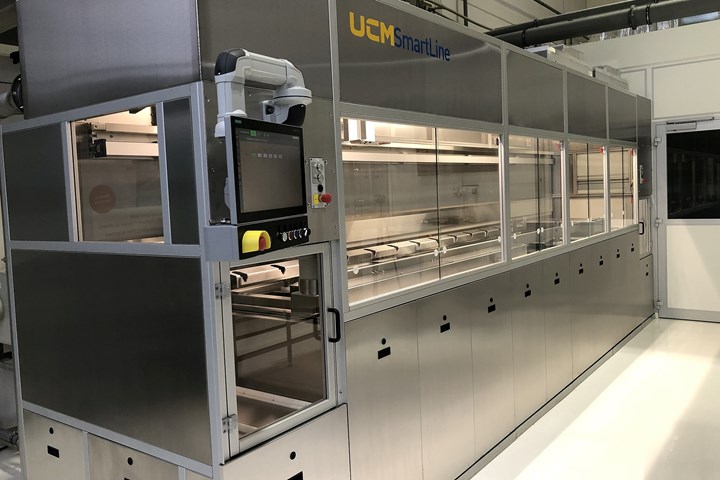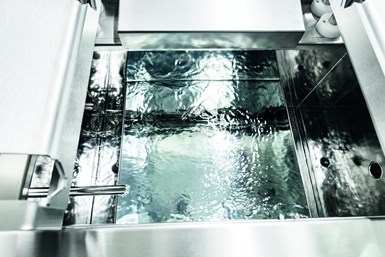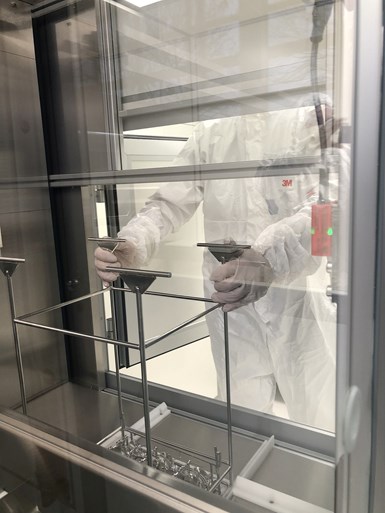As the U.S. Environmental Protection Agency (EPA) is changing some manufacturing cleaning regulations, the U.S. Food and Drug Administration (FDA) is also altering its requirements for cleaning medical devices. These modifications are causing medical device manufacturers and suppliers to adjust their cleaning and passivation processes.
A company that manufactures titanium knee implants was forced to change its cleaning system to enable validating its intermediate cleaning process, and monitoring and documenting its final cleaning process. With the implementation of the UCMSmartLine from Swiss company UCM AG, a division of SBS Ecoclean, the manufacturer was equipped to reach its stringent cleaning goals for its customers.
By creating stricter medical cleaning requirements, the FDA followed the lead of the European Medical Device Regulation (MDR) that was recently introduced. The MDR requires more rigid medical device cleaning, documenting, validating and tracing processes. By harmonizing its quality system regulations with the MDR, the FDA makes it easier for medical device manufacturers to comply with requirements no matter if products are manufactured in the U.S. or Europe.
Choosing the Right System
After researching new cleaning equipment options that could help the knee implant manufacturer comply with new regulations, the company opted for the UCMSmartLine system. The deciding factor was the concept of the ultrasonic multichamber immersion cleaning system, which is based on standardized modules for cleaning, passivation, rinsing and drying as well as loading and unloading.
The UCMSmartLine concept, which is based on standardized modules, enables the ultrasonic immersion cleaning systems to be individually configured for intermediate and final cleaning applications, also with direct connection to a clean room. Photo Credit: UCM
The parts to be cleaned are transported by an integrated automated system, complete with a servodrive that comes standard on the system. The electric and controls are integrated into each unit, so extra space for a control cabinet is not needed.
Equipped with modern sensor technology and additional methods for measuring parameters such as pH, conductivity, density, ultrasonic frequency and output, all relevant process parameters can be recorded, controlled and documented. The data is transmitted to the company's higher level Manufacturing Executive System via an interface integrated into the cleaning system’s PC-based controller.
Customized Cleaning Is the Bee’s Knees
Because of the flexible plug-and-play design, the cleaning system for the knee implants can be individually configured for pre-cleaning, intermediate cleaning and final cleaning applications for the highest cleanliness requirements.
The standard two-sided overflow creates an uninterrupted flow that enhances the intensive treatment of the parts. It also guarantees that contaminants are immediately discharged from the treatment tanks. Photo Credit: UCM
For batch-by-batch intermediate cleaning of the implants, in which residues from grinding or polishing processes are removed, the fully enclosed system has a total of six wet stations with tanks measuring 370 × 420 × 390 mm). During the two cleaning and four rinsing cycles, multifrequency ultrasound with 25 and 40 kHz is used in addition to injection flood washing and pulsed pressure cleaning (PPC). The two-sided overflow developed by UCM, which comes standard, also contributes to the consistently good cleaning result: media are introduced from below, transported to the top and then overflow on two sides. This creates a constant flow that not only promotes intensive treatment of the parts but also ensures that detached particles and other residues are immediately removed from the baths. This minimizes the risk of recontamination when parts are moved or lifted out of the system.
After final cleaning, the parts are discharged to the clean room. Consistent monitoring and the comparison of process parameters with validated values ensure that “bad baskets” of parts are eliminated before they reach the clean room. Photo Credit: UCM
After the drying step in the integrated vacuum dryer, the implants are subjected to a full visual inspection.
A Clean Sweep
The UCMSmartLine configured for final cleaning of the implants has seven wet stations. The cleaning and rinsing steps are followed by passivation, during which the quality of the medium is monitored by measuring its density. After neutralization, the parts are subjected to three rinsing steps with corresponding water qualities. Cleaning and rinsing are also reinforced by injection flood washing, PPC and ultrasound with a frequency of 40 kHz during final cleaning.
The newly developed Acoustic Performance Measurement system provides inline monitoring of the parameters for ultrasonic frequency and output at each processing station for each batch. Special directional microphones are used for monitoring, which are placed in a fixed position at the edge of each tank and directed toward the center of the bath surface. Thus, measurements are carried out without any movement or contact, ensuring reproducible results. Analysis, evaluation and storage of the data are handled by the measuring system software.
The modular final cleaning system used to clean the knee implants has seven wet stations for cleaning, passivation, neutralization and rinsing, as well as a vacuum dryer. Photo Credit: UCM
Because of the special lift-out function of the transport system, the parts are effectively pre-dried following the last rinse before being transferred to the vacuum dryer. Here, the final drying step dries the parts completely without spotting.
At the outfeed section, the system is connected to the clean room by a double airlock. Due to consistent monitoring of the process parameters and the continuous comparison with validated process data, baskets containing bad parts can be removed from the product flow before reaching the clean room.
Because of the highly flexible design of the system and processes, the UCMSmartLine is suitable for a range of applications, not only for the medical industry.
Ecoclean Inc. | ecoclean-group.net
About the Author
Doris Schulz
Doris Schulz has studied business administration and founded her own PR agency in 1995 in Germany. One of her specialties is the field of surface treatment.
Related Content
Photochemical Etching Explained
This subtractive metal fabrication process is an alternative to traditional methods which enables designers to create thin metal parts with intricate shapes to micron-level precision without leaving behind burrs.
Read MoreGerman Project Yields Three New Medical Machining Processes
Recent research has resulted in a new mix of high-speed turn whirl milling, polygon turning and rotational turning for manufacturing medical bone screws and out-of-round nails.
Read MoreHow Small Machine Shops Can Fight Supply Chain Problems
Supply chain disruptions are still presenting challenges in manufacturing. This article examines the effects on aerospace, automotive and medical industries. It also covers ways that machine shops can be successful securing work despite the challenges created by the supply chain.
Read MoreThe Control’s Role in Machining Complex Parts
This company that produces medical implants finds value in the CNC for its turn-mill equipment that helps speed setups and simplify programming when producing intricate parts complete.
Read MoreRead Next
Emerging Leaders Nominations Now Open
Here’s your chance to highlight a young person in your manufacturing business who is on the path to be a future leader moving your company forward.
Read MoreDo You Have Single Points of Failure?
Plans need to be in place before a catastrophic event occurs.
Read MoreA Tooling Workshop Worth a Visit
Marubeni Citizen-Cincom’s tooling and accessory workshop offers a chance to learn more about ancillary devices that can boost machining efficiency and capability.
Read More


























